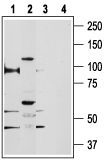Overview
- Peptide (C)GLNLSEGDGEEVYHF, corresponding to amino acid residues 715-729 of human TRPV5 (Accession Q9NQA5). Intracellular, C-terminus.

 Western blot analysis of rat kidney (lanes 1 and 3) and human PC3 prostate cancer cell line (lanes 2 and 4) lysates:1,2. Anti-TRPV5 Antibody (#ACC-035), (1:200).
Western blot analysis of rat kidney (lanes 1 and 3) and human PC3 prostate cancer cell line (lanes 2 and 4) lysates:1,2. Anti-TRPV5 Antibody (#ACC-035), (1:200).
3,4. Anti-TRPV5 Antibody, preincubated with TRPV5 Blocking Peptide (#BLP-CC035).
 Expression of TRPV5 in rat kidneyImmunohistochemical staining of rat kidney paraffin embedded section using Anti-TRPV5 Antibody (#ACC-035), (1:100). TRPV5 is expressed in collecting ducts (CD) in the renal cortex. Note that both proximal tubules (PT) and distal tubules (DT) are negative. Hematoxilin is used as the counterstain.
Expression of TRPV5 in rat kidneyImmunohistochemical staining of rat kidney paraffin embedded section using Anti-TRPV5 Antibody (#ACC-035), (1:100). TRPV5 is expressed in collecting ducts (CD) in the renal cortex. Note that both proximal tubules (PT) and distal tubules (DT) are negative. Hematoxilin is used as the counterstain.- Mouse kidney sections (Loh, N.Y. et al. (2013) PLoS ONE 8, e55412.).
 Expression of TRPV5 in PC3 cellsImmunocytochemical staining of paraformaldehyde-fixed PC-3 cells with Anti-TRPV5 Antibody (#ACC-035), (1:100), followed by goat anti-rabbit-AlexaFluor-555 secondary antibody (A). B. Same as in (A) but pre-treated with TRPV5 peptide antigen (1:20). Hoechst 33342 is used as the counterstain (blue).
Expression of TRPV5 in PC3 cellsImmunocytochemical staining of paraformaldehyde-fixed PC-3 cells with Anti-TRPV5 Antibody (#ACC-035), (1:100), followed by goat anti-rabbit-AlexaFluor-555 secondary antibody (A). B. Same as in (A) but pre-treated with TRPV5 peptide antigen (1:20). Hoechst 33342 is used as the counterstain (blue).
- Montell, C. et al. (2002) Mol. Cell. 9, 229.
- Clapham, D.E. (2003) Nature 426, 517.
- Moran, M.M. et al. (2004) Curr. Opin. Neurobiol. 14, 362.
- Clapham, D.E. et al. (2003) Pharmacol. Rev. 55, 591.
- Gunthorpe, M.J. et al. (2002) Trends. Pharmacol. Sci. 23, 183.
- Hoenderop, J.G. et al. (2003) Pflugers. Arch. 446, 304.
- Peng, J.B. et al. (2003) J. Physiol. 551, 729.
TRP channels are a large family (about 28 genes) of plasma membrane, non-selective cationic channels that are either specifically or ubiquitously expressed in excitable and non-excitable cells.1 According to IUPHAR, the TRP family is comprised of three main subfamilies on the basis of sequence homology; TRPC, TRPM and TRPV (to date, three extra subfamilies are considered to belong to the TRP family; the TRPA, TRPML, and TRPP).1-4 The TRPV subfamily consists of six members, TRPV1-6.5
TRPV5 (ECaC) and TRPV6 (CaT1) are unique members of the TRP family. Both are epithelial Ca2+ channels, form constitutively open channels, share high degree of homology (about 66%) with differences in the N- and C-terminus. TRPV6 and TRPV5 are expressed in a 1,25-dihydroxyvitamin D3 dependent manner. In contrast to other members of the TRP family, TRPV5 and TRPV6 are highly Ca2+ selective and are expressed in Ca2+ transporting epithelia where they are assumed to have an important role in Ca2+ reabsorption.6,7 TRPV5 is preferentially expressed in the kidney.
Application key:
Species reactivity key:
Alomone Labs is pleased to offer a highly specific antibody directed against an epitope of human TRPV5. Anti-TRPV5 Antibody (#ACC-035) can be used in western blot, immunocytochemistry and immunohistochemistry applications. It has been designed to recognize TRPV5 from human, mouse and rat samples.
Applications
Citations
- Rat brain lysate (1:1000).
Park, S.Y. et al. (2020) J. Chem. Neuroanat. 105, 101767. - Mouse kidney lysate.
Wang, L. et al. (2015) J. Am. Soc. Nephrol. 26, 2678.
- Rat brain sections (1:500).
Park, S.Y. et al. (2020) J. Chem. Neuroanat. 105, 101767. - Mouse kidney sections.
Alexander, R.T. et al. (2015) Am. J. Physiol. 309, F604. - Mouse kidney sections.
Loh, N.Y. et al. (2013) PLoS ONE 8, e55412.
- Li, S. et al. (2010) Mol. Biol. Rep. 37, 1287.
- Irnaten, M. et al. (2009) Steroids 74, 642.
